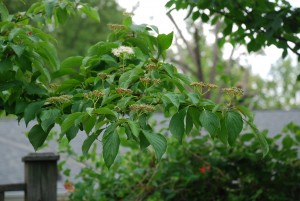Pagoda dogwood (Cornus alternifolia), aka alternate leaf dogwood, is a small deciduous tree or large multi-stemmed shrub. It typically grows 15-25 feet tall and spreads slightly wider than tall. It exhibits a very distinctive layered horizontal branching.
Small creamy white non-bracted flowers appear as flattened cymes in mid to late spring, about 3-4 weeks after flowering dogwood (C. florida) has finished. Its sweet flower fragrance, in my opinion, would not be an outstanding trait.
While the leaves of most dogwoods (Cornus spp.) are arranged opposite, pagoda dogwood’s leaves are alternate. The medium to dark green leaves are unusually parallel-veined; leaf size varies from 2-4 inches in length.
Bluish-black fruits (drupes) ripen in late summer and are favorites of many species of birds. Autumn leaf hues are insignificant. Disease and pest problems are rare when the pagoda dogwood is properly sited. Deer appear to pester it very little.
Grow pagoda dogwood in acidic, compost-rich, and well-drained moist soil. Pagoda dogwood is hardy to northerly zone 3 where it grows in full day sunlight. Protection from afternoon sun in southerly climes (zones 6 and 7) is highly recommended.
Plant this small flowering tree where it can be seen such as near a patio or in a woodsy area to attract hungry birds. Pagoda dogwood needs little annual maintenance other than to prune off occasional basal suckers.
Two variegated leaf forms are sold at garden centers and e-commerce nurseries. ‘Argentea’ features attractive silvery white variegated foliage on layered horizontal branches. It grows into a 10 to 15 ft. tall shrub. Golden Shadows® also grows shrub-like with layered horizontal branching and gold variegated foliage.


 Posted in
Posted in 
